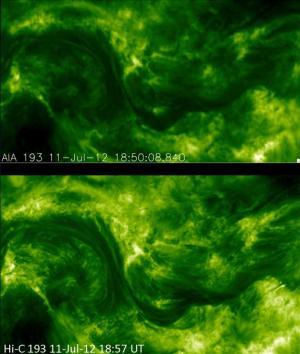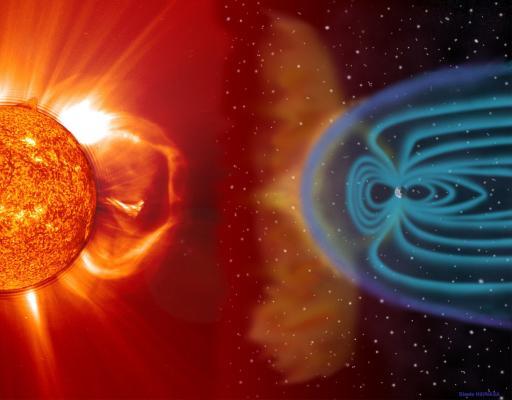
U.S. astronomers have released what they say are the highest-resolution images ever captured of the Sun’s corona, its million-degree outer atmosphere.
NASA’s High Resolution Coronal Imager, or Hi-C, on July 11 launched a sounding rocket and captured the 16-megapixel images in an extreme-ultraviolet wavelength of light.
“Even though this mission was only a few minutes long, it marks a big breakthrough in coronal studies,” Leon Golub of the Harvard-Smithsonian Center for Astrophysics said.
The new images contain five times as much detail as the next-best observations by NASA’s Solar Dynamics Observatory, the Harvard-Smithsonian center reported.
The Sun’s corona is filled with ionized gas, or plasma. It mainly emits X-ray and extreme-ultraviolet wavelengths.
Solar scientists have long tried to understand why the corona is so hot, and why it erupts in violent solar flares and related blasts known as “coronal mass ejections,” which can produce harmful effects when they hit Earth.
Hi-C focused on an active region on the sun featuring a sunspot selected specifically for its large size and active nature.

<관련 한글 기사>
’태양 폭풍’의 비밀 밝혀지나?
미국 천문학자들이 태양의 코로나를 찍은 역대 최고 해상도의 사진을 공개했다.
미국항공우주국(NASA)의 고해상도 코로나 분광복사계(Hi-C)는 탐사 로켓을 발사시켜 태양의 초강력 자외선 파장을 1600만 화소로 담아냈다.
하버드-스미소니언 천문학 센터에 따르면 이번 탐사 로켓의 미션은 짧은 시간 내에 수행되었지만, 코로나 연구에 획기적인 발판을 마련했다.
이번에 찍힌 사진들은 NASA의 태양활동관측위성이 찍은 기존의 최고 해상도 사진에 비해 다섯 배나 더 세밀하다.
태양 대기권의 가장 바깥층인 코로나는 이온화된 가스나 플라즈마로 이루어져있으며, 100만도에 달하는 고온으로 X선과 자외선 파장을 방출한다.
과학자들은 코로나가 태양 대기권의 가장 바깥층임에도 불구하고 어떻게 표면보다 뜨거울 수 있는지, “코로나 질량 방출”의 원인이 무엇인지 연구해 왔다. 코로나 질량 방출은 ‘태양 폭풍’으로 일컬어지며 지구의 자기장에 심각한 영향을 미친다.
지난 7일 오전에도 태양흑점 폭발 현상이 발생해 약 30분간 단파통신(HF) 장애가 일어났었다.
NASA는 지구 3배 이상 크기의 흑점으로 150년 만의 최대 규모 흑점 폭발이 2013년 5월 극대기에 접어들 것이라고 전망한 바 있다.
코리아헤럴드
(khnews@heraldcorp.com)




![[Grace Kao] Hybe vs. Ador: Inspiration, imitation and plagiarism](http://res.heraldm.com/phpwas/restmb_idxmake.php?idx=644&simg=/content/image/2024/04/28/20240428050220_0.jpg&u=)

![[Herald Interview] Mom’s Touch seeks to replicate success in Japan](http://res.heraldm.com/phpwas/restmb_idxmake.php?idx=644&simg=/content/image/2024/04/29/20240429050568_0.jpg&u=)


![[News Focus] Lee tells Yoon that he has governed without political dialogue](http://res.heraldm.com/phpwas/restmb_idxmake.php?idx=644&simg=/content/image/2024/04/29/20240429050696_0.jpg&u=20240429210658)








![[Today’s K-pop] Seventeen sets sales record with best-of album](http://res.heraldm.com/phpwas/restmb_idxmake.php?idx=642&simg=/content/image/2024/04/30/20240430050818_0.jpg&u=)